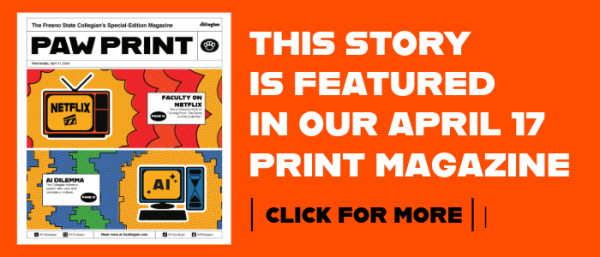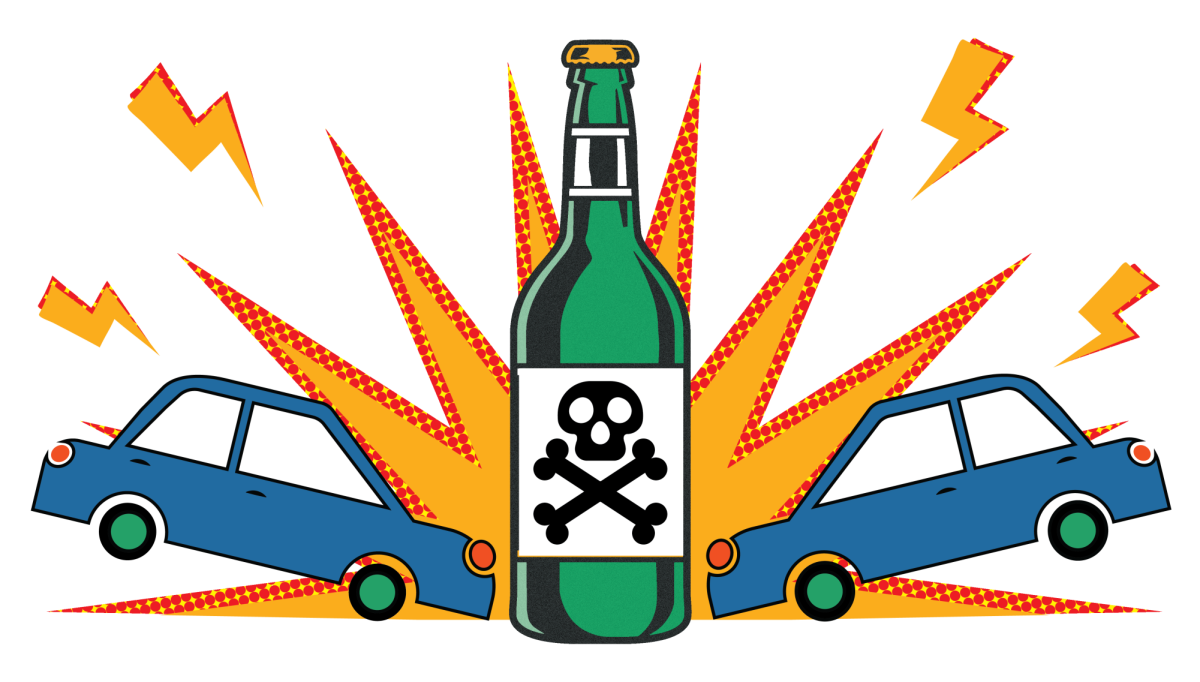1,825. That’s how many college students die every year due to alcohol-related driving incidents.
That’s 1,825 classmates, co-workers, friends and family members.
You shouldn’t have to drive at night with the fear of losing your life because of someone else’s irresponsible choice to drive while intoxicated.
For Fresno residents, that fear is a reality. A study conducted by The National Highway Traffic Safety Administration found that among the top 100 most populated cities in the United States, Fresno was the third most dangerous to drive in.
That number is alarming regardless of the circumstances, but it’s especially concerning in a city that has over half a million residents, hundreds of K-12 schools and multiple colleges.
 Since 2021, there have been 14 DUIs near the surrounding areas of the Fresno State campus—six in 2021, three in 2022, three in 2023 and two so far this year. With the alarming number of drunken driving accidents, it’s time for Fresno State and Fresno to be proactive and try to come up with a solution.
Since 2021, there have been 14 DUIs near the surrounding areas of the Fresno State campus—six in 2021, three in 2022, three in 2023 and two so far this year. With the alarming number of drunken driving accidents, it’s time for Fresno State and Fresno to be proactive and try to come up with a solution.
One way Fresno State can improve its safety measures is by incorporating a safe ride program that is already used by several universities nationwide.
Gitnux conducted multiple studies regarding college students and drunken driving. The numbers reported are concerning.
Some of the most alarming stats were how 33% of students surveyed admitted to driving after drinking alcohol.
While the website didn’t specify how much alcohol intake the surveyors had, it’s still upsetting to see, even if they are below the legal BAC limit. College athletes are nearly twice as likely to drink and drive than non-athletes, and freshmen who drink and drive are more likely than upperclassmen.
Knowing that around one out of every three college students drink and drive at one point in their lives should be a point of distress for everyone since these same people are your classmates, coworkers and friends.
Obviously, it’s disappointing to see anyone make the stupid decision to drink and drive. Still, it’s even more frustrating to see athletes, the people who are supposed to represent the university and be role models in the community, make these idiotic choices.
Both of these categories were apparent earlier in April when a Nebraska volleyball player got arrested for driving with a BAC of 0.169, which is double the legal limit in Nebraska. That act is inexcusable in itself, considering that the athlete, Harper Murray, is just a freshman. To make matters worse, she was also caught having fake IDs.
Having a fake ID is a poor choice regardless of who you are, but when you’re a Division I athlete and play for a team that made the national championship, using a fake identity probably isn’t the best idea.
There is a 40% statistic of college students who drove over the legal limit of .08 BAC. It’s worrying that many of the students who were below the limit still drove, knowing they were consuming alcohol earlier that night.
The popularity of rideshare services such as Uber and Lyft has reduced the number of drunken driving accidents across the country over the last few years.
A 2020 survey conducted by Lyft reported that ridesharing decreased fatal alcohol crashes by 11.4% across the United States. Not only that, but over 50% of people are less likely to drive due to the availability of rideshare apps.
However, it’s well-known across the country that college students aren’t made of money. Both Lyft and Uber have seen their prices increase over the past few years. That’s why college students need something affordable to help take them to and from a night out.
Public transportation in Fresno is cheap and mostly easy to get to, but there are several reasons as to why this isn’t a feasible solution for students who need a safe ride home after an outing.
Last fall, the City of Fresno unveiled The Hop, a free bus trolley system that would help the nightlife in Fresno and Fresno State students navigate safely around town at night.
While it is somewhat true, it is also misleading. The trolley only operates Thursday-Saturday, Thursdays from 5 p.m.-12 a.m., and on Fridays and Saturdays from 5 p.m.-1 a.m. The routes are also predetermined, only making stops at Campus Pointe, Downtown, Tower District and Fresno City College.
Jimbo’s and Old Town Saloon are two of the most popular bars among Fresno State students.
However, neither of these bars is along the route for The Hop. Another issue is that Jimbo’s, along with other clubs in Tower, doesn’t close until 2 a.m., so even if it were on the route, most people would have to leave an hour early to catch The Hop.
The Hop isn’t the only means of public transportation in Fresno. The Fresno Area Express (FAX) is Fresno’s primary public transportation service and can be traced all the way back to the 1800s.
Just like The Hop, FAX does a good job serving its purpose, but it’s not designed to get students home during the night.
FAX has 24 different routes within Fresno and Clovis and it feels like you can’t drive for longer than a minute without seeing an FAX stop. The other problem is that FAX only operates until 10 p.m. on weekdays.
The Hop is unquestionably a step in the right direction for Fresno, but why stop there? There is so much more the city of Fresno, and Fresno State can do to ensure its students are getting home from a night out safely, which should be any university’s number one priority.
One of these ways is implementing a ride-share system that would get students from point A to point B during the night.
The National Association of Safe Ride Programs (NRSA) partnered with several universities across the country and does precisely that.
Since student fees fund safe ride programs, all rides are free regardless of how many times someone rides throughout the semester.
Some of the universities that utilize the Safe Ride program are Colorado State University, Oregon State University, Western Oregon University and Michigan State University.
Colorado State’s “Ram Ride” has been around since 2003.
Bertha Mendoza, volunteer coordinator for Ram Ride, believes that safety and cost are advantages the Ram Ride has over other methods of transportation.
“The student fees that a student pays for a Ram Ride are usually more affordable than the cost of a Lyft or Uber, especially if a student is using our services multiple times a semester,” Mendoza told The Collegian. “Secondly, all of our drivers and navigators are also CSU students, so our students have expressed a larger sense of safety while taking a Ram Ride versus other ride-share services due to this reason.”
Ram Ride also pays its volunteer drivers, who can earn up to $500-1000 a night. So, if a safe ride program were to be added at Fresno State, it would also create more jobs for students and give them another way to collect income.
Even though it only operates on Friday and Saturday nights, the hours are from 10 p.m. to 2:30 a.m., which makes sense since those are the most popular days to go out.
Ram Ride doesn’t just take students to the surrounding area of campus, but anywhere in the city limits of Fort Collins. Just like Uber and Lyft, Ram Ride uses an app that allows students to schedule rides.
Sammy Trout is the community outreach coordinator for Ram Ride, and he believes that universities across the country would benefit from adding a safe ride program on their campus.
“I think having Safe Ride programs across campuses nationwide is an excellent example of harm reduction,” Trout said. “We know students are going to be either drinking or they’re going to be out for whatever reason. It’s important to have systems in place to help prevent an accident from happening. It’s awesome. It’s a great community builder.”
Even though not all of these operate all week, this would undoubtedly be an upgrade given the current options students at Fresno State have for transportation due to price, accessibility and other reasons.
While implementing this at Fresno State would cause a hefty price, it is unquestionably worth the cost if it means that students and faculty can get home safely without having the risk of getting a DUI or something even worse.




